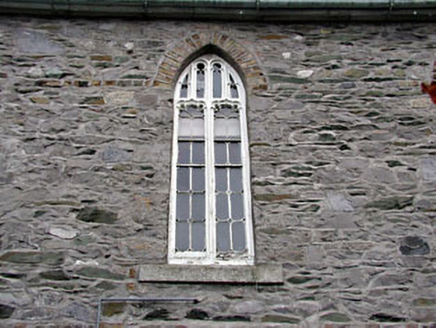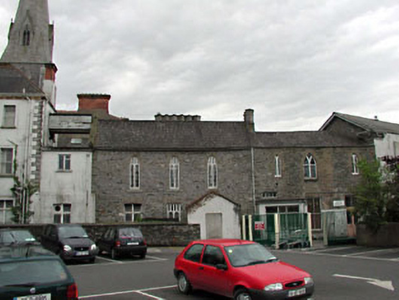Survey Data
Reg No
11814116
Rating
Regional
Categories of Special Interest
Architectural, Historical, Social
Original Use
Building misc
In Use As
Building misc
Date
1800 - 1840
Coordinates
289354, 219717
Date Recorded
23/05/2002
Date Updated
--/--/--
Description
Attached three-bay three-storey rubble stone Gothic-style building, c.1820, on a cranked plan with three-bay two-storey lower wing to north-west. Renovated, c.1900, with single-bay single-storey gabled projecting porch added to ground floor. Renovated, c.1960, with single-bay single-storey flat-roofed advanced bay added to ground floor on a shallow triangular plan. Gable-ended roofs on an cranked plan with slate. Clay ridge tiles. Rendered chimney stack. Rendered coping to gables. Cast-iron rainwater goods. Gabled to porch. Corrugated-iron. Rendered coping to gables. Flat-roofed to advanced bay. Bitumen felt. Random rubble stone walls. Repointed, c.1960. Rendered walls to porch and to advanced bay. Unpainted. Square-headed openings to ground floor. Stone sills. Red brick dressings. Pointed-arch window openings to first floor. Stone sills. Brick dressings. Traceried fixed-pane timber windows. Square-headed openings to porch now blocked-up. Square-headed window opening to advanced bay. Concrete sill. Timber casement window. Set back from road in grounds shared with Catholic church and convent.
Appraisal
This building, the original and present purposes of which are uncertain, is an attractive feature of a complex that includes a Catholic church (11814052/KD-19-14-52) and convent (11814053/KD_19-14-53) – the construction in rubble stone with brick dressings distinguishes the building amongst its neighbours, which are mostly rendered. The building retains many original features and materials, including traceried timber windows to the attractively-shaped openings, and a slate roof with cast-iron rainwater goods. Remodelled to part ground floor in the late twentieth century, the additional advanced bay does not complement the original integrity of the building, although it is an easily-removed feature. The building is of some social and historic importance, representing the continued expansion of a Catholic quarter in the town in the early nineteenth century.



